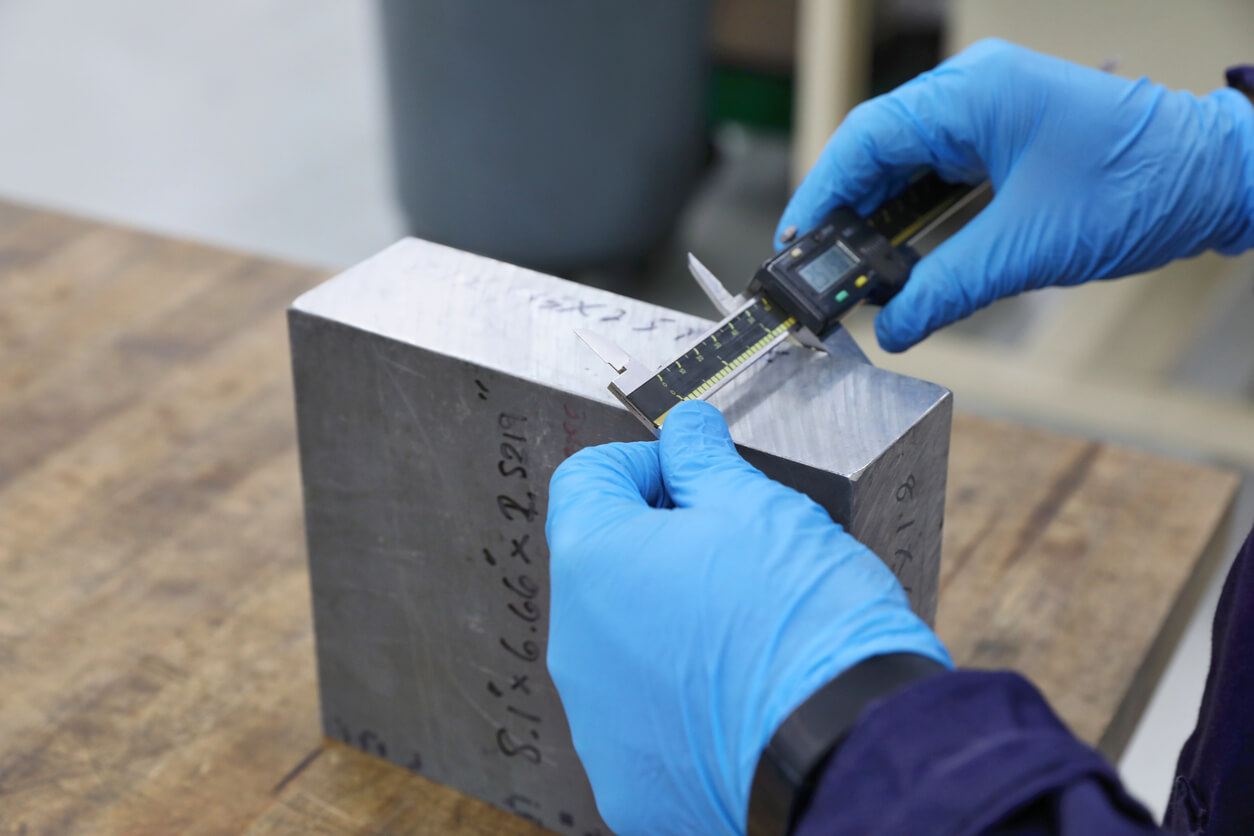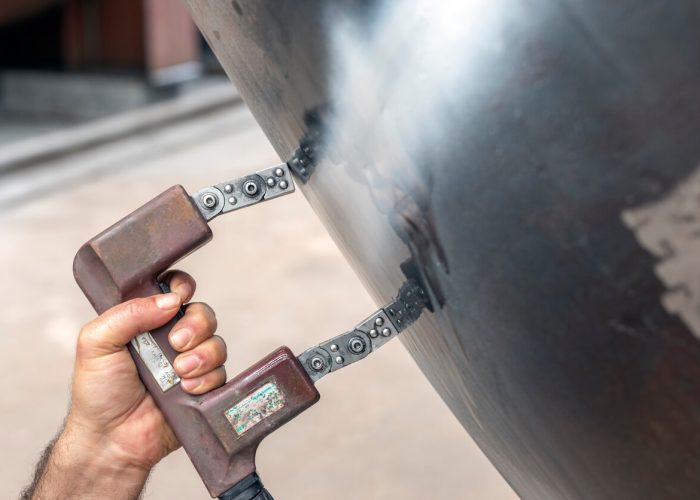Izod Impact Testing
In the world of materials testing, we can’t overlook the importance of Izod impact testing. This method offers us vital insights into a material’s ability to withstand sudden forces, providing valuable data for various industries. We’ll examine the key components of the test, its standardization procedures, and the factors that influence results. Understanding how to interpret Izod impact data is essential for engineers and designers alike.

Key Points
- Izod impact testing evaluates a material’s ability to withstand sudden force by measuring impact resistance and fracture initiation energy.
- The test uses a notched specimen, pendulum impact fixture, and clamping vise to ensure standardized and accurate measurements.
- ASTM D256 governs Izod impact testing standardization, specifying specimen dimensions, preparation guidelines, and reporting requirements.
- Factors influencing test results include material properties, specimen geometry, temperature, strain rate, and fracture type.
- Izod testing is widely applied in automotive, electronics, construction, and crashworthiness assessments to determine material toughness.
Understanding Izod Impact Testing
Izod Impact Testing is a vital method for evaluating a material’s ability to withstand sudden force. We use this test to measure a material’s impact resistance and determine the kinetic energy necessary for fracture initiation. When we perform Izod Impact testing, we utilize notched specimens to prevent deformation, which is essential for quality control and comparing different materials. This test is similar in principle to the Charpy Impact Testing method, as both assess the material’s toughness through the energy absorbed during fracture.
The test involves a pendulum striking the specimen, and we express the impact energy in units like J/m or ft-lb/in. To make sure we get accurate results, we average the data from multiple specimens.
It’s worth mentioning that ASTM and ISO standards define specific specimen sizes for Izod testing, ensuring consistency across different laboratories. We can also conduct Izod Impact testing at reduced temperatures to evaluate a material’s performance in various environmental conditions. When calculating impact strength, we consider both the energy absorbed and the specimen’s thickness or area.
As materials scientists and engineers, we rely on Izod Impact testing to make informed decisions about material selection and to develop new materials with improved impact resistance.
Key Components of Izod Test
For conducting an Izod impact test, several key components are essential. Let’s explore these pivotal elements that enable us to accurately measure a material’s impact resistance and energy absorption capabilities.
- Notched specimen: We start with a carefully prepared test specimen featuring a standardized notch. This notch acts as a stress concentrator, allowing us to evaluate how materials respond to impact under controlled conditions. The dimensions of the notch, similar to DWTT, must be meticulously prepared to guarantee consistent and reliable results.
- Pendulum impact test fixture: The heart of our Izod testing setup is the pendulum apparatus. It delivers a precise, measured impact to the specimen, enabling us to quantify the energy absorbed during deformation.
- Clamping vise: We secure the specimen firmly in place using a specialized vise, ensuring uniform positioning for each test.
- ASTM standardization: As members of the materials testing community, we adhere to ASTM International standards, ensuring reliable and comparable results across different testing facilities.
These components work together to provide valuable insights into material toughness, impact energy, and ductile-to-brittle shift temperature. By analyzing how ductile materials and other polymers perform under impact loading, we can make informed decisions about material selection and design optimization in various industries.
Standardization and Test Procedures
We’ll examine the key requirements of ASTM D256, which governs Izod impact testing standardization. This standard outlines precise specimen preparation guidelines, ensuring consistent and reliable test results.
We’ll focus on the critical aspects of specimen notching, dimensions, and conditioning procedures that must be followed to comply with ASTM D256 specifications.
ASTM D256 Key Requirements
The cornerstone of standardized Izod impact testing, ASTM D256, outlines fundamental requirements for consistent and reliable results. We’ll explore the key aspects of this standard, which guarantees uniformity in evaluating impact strength and material toughness across the industry.
CTOD testing, vital for evaluating fracture toughness, complements Izod testing by providing insights into material resistance to crack propagation under mechanical loading.
ASTM D256 specifies:
- Standard specimen dimensions, typically 3.2mm thick with different width options
- Notched specimen preparation for evaluating fracture behavior
- Precise testing procedures to measure energy lost during impact
- Reporting guidelines for expressing results per unit thickness or cross-sectional area
We’ve adopted these requirements to maintain consistency in our Izod Impact testing practices. By adhering to ASTM D256, we’re able to produce comparable results with other laboratories worldwide. It’s worth noting that ISO 180 methods, used in Europe, align with ASTM D256 to ensure global consistency in plastics testing.
Understanding these key requirements is essential for anyone involved in materials testing. We’re committed to following these standards, as they provide valuable insights into a material’s performance under impact conditions. By consistently applying ASTM D256, we can confidently evaluate and compare the toughness of various plastics, contributing to advancements in material science and engineering.
Specimen Preparation Guidelines
Precise specimen preparation is necessary for obtaining reliable and reproducible results in Izod impact testing. We must adhere to standardized specimen dimensions, typically 2.16 inches in length, 0.39 inches in width, and 0.39 inches in thickness. Notched specimens are vital for creating a stress concentration point, guaranteeing accurate measurement of impact energy results.
Let’s take a closer look at the key aspects of specimen preparation:
| Parameter | Specification | Purpose |
| Dimensions | 2.16″ x 0.39″ x 0.39″ | Standardization |
| Notch Angle | 45 degrees | Stress concentration |
| Notch Radius | 0.25 mm | Consistent failure point |
| Conditioning | Specific temperature and humidity | Uniform properties |
We must carefully create the notch with a 45 degrees angle and a 0.25 mm radius of curvature at the apex. This precise geometry ensures consistent stress concentration across all specimens. Before testing, we’ll condition our specimens at specific temperature and humidity levels to maintain uniform material properties. By following these guidelines, we’ll achieve accurate and comparable Izod impact energy results, expressed in joules per meter or foot-pounds per inch, depending on the standard we’re following.
Factors Influencing Test Results
Several key factors influence the results of Izod impact testing, each contributing to the overall assessment of a material’s impact strength. We must consider yield strength, as higher values typically correlate with lower impact strengths. Ductility plays a pivotal role, with more malleable materials generally exhibiting higher impact strengths due to their ability to deform before fracture. The test specimen geometry is also crucial in determining crack behavior and displacement measurement, which directly impacts test results.
Notches in the specimen are crucial, as they localize stresses during the Izod impact test. The notch tip radius and depth significantly impact the results.
Temperature and strain rate also affect impact strength, with sensitivity to strain rate increasing at lower temperatures.
We classify fractures in Izod testing as either ductile or brittle. Ductile fractures are typically dominated by microvoid coalescence, while brittle fractures exhibit less plastic deformation.
To ensure accurate and reliable results, we must consider:
- Material properties (yield strength, ductility)
- Specimen geometry (notch characteristics)
- Testing conditions (temperature, strain rate)
- Fracture mechanisms (ductile vs. brittle)
Interpreting Izod Impact Data
Having examined the factors influencing Izod test results, we’ll now focus on interpreting the data obtained from these tests.
The Izod impact test provides us with vital information about a material’s impact strength, typically expressed in energy units like joules per meter or foot-pounds per inch. To calculate impact strength, we divide the energy absorbed by the specimen’s thickness.
It’s important to note that both ASTM and ISO standards have specific guidelines for interpreting Izod impact data. The ASTM standard requires us to average the impact results from five specimens to ensure precision. On the other hand, the ISO standard calculates impact strength by dividing the energy by the area under the notch.
We use notched specimens in Izod testing to prevent distortion and allow for precise measurement of a material’s resistance to impact. This approach helps us obtain more reliable and consistent results.
When interpreting the data, we must consider the specimen’s thickness and the notch’s impact on the results. By following these standardized methods, we can effectively compare different materials and make informed decisions about their suitability for various applications.
Applications Across Industries
We’ll examine how Izod impact testing plays a pivotal role across multiple industries.
In the automotive sector, it guides material selection for vehicle components, ensuring peak safety and performance.
Izod testing is essential for electronics durability assessments and helps establish construction safety standards, demonstrating its widespread applicability in diverse fields.
Automotive Material Selection
Automotive material selection is a vital process that depends heavily on Izod impact testing to evaluate the toughness and energy absorption capabilities of materials used in vehicle components. We use this testing method to guarantee that the materials we choose can withstand impact forces during accidents or collisions, meeting strict safety standards and protecting passengers.
In the automotive industry, we employ Izod testing for several important purposes:
- Evaluating the crashworthiness of vehicle structures and components
- Contrasting the impact resistance of different materials
- Fine-tuning material selection for specific automotive applications
- Validating the performance of new materials or composites
By analyzing Izod impact test results, we can make informed decisions about material selection, enhancing the overall safety and durability of our automotive designs. This analytical approach allows us to identify materials that offer the best combination of toughness and energy absorption for specific vehicle components.
As automotive engineers, we rely on Izod testing to guide our material choices, ensuring that each component meets or exceeds safety requirements. This commitment to rigorous testing and analysis helps us create vehicles that provide the best protection for occupants in the event of a collision.
Electronics Durability Testing
While Izod testing is vital in automotive material selection, it represents just one facet of durability testing across industries. In electronics durability testing, we employ a diverse array of methods to guarantee our devices can withstand various environmental factors and usage conditions. Unlike the Izod test, which primarily focuses on impact strength using an Izod pendulum, electronics testing evaluates a broader range of durability aspects.
We assess impact resistance, vibration tolerance, thermal performance, and overall reliability of electronic components. These thorough testing methods help us identify weak points in our designs and improve product quality.
As members of the electronics industry, we must adhere to strict industry standards such as MIL-STD-810G and IEC 60068. Compliance with these standards is essential for ensuring our products meet the rigorous demands of automotive, aerospace, and consumer electronics sectors.
Construction Safety Standards
Construction safety standards shape the foundation of workplace protection across various industries, extending far beyond their namesake sector. We’ve observed these standards applied in manufacturing, engineering, and transportation, promoting safe work environments and reducing accidents. By adhering to these regulations, we’re not only safeguarding our workforce but also enhancing productivity and efficiency.
When we consider construction safety standards in relation to material testing, such as the Izod impact test, we can draw valuable parallels. Both aim to guarantee the integrity and safety of our products and structures. Just as the Izod test measures impact strength and notch sensitivity, safety standards assess:
- Equipment safety and proper usage
- Adequate worker training and hazard communication
- Emergency preparedness and response protocols
- Compliance with ASTM and ISO guidelines
Our commitment to these standards, much like our dedication to rigorous testing methods, leads to significant benefits. We experience cost savings, legal compliance, and an enhanced reputation.
Frequently Asked Questions
What Is the IZOD Test?
We use the Izod test to measure a material’s impact resistance. It’s our go-to method for determining the energy needed to break a notched specimen. We rely on it to assess toughness in various materials, especially polymers.
What Is the Difference Between Izod and Charpy Test?
We’ll find key differences between Izod and Charpy tests in specimen orientation, notch direction, and impact point. Izod uses horizontal specimens with outward-facing notches, while Charpy employs vertical specimens with inward-facing notches. Let’s explore these distinctions further.
How to Read Izod Impact Test Results?
To read Izod impact test results, we’ll look at the energy absorbed per unit thickness. We’ll average five specimens’ values, typically in J/m or ft-lb/in. Let’s consider notch effects and compare to industry standards.
What Is the ASTM Standard for Izod Impact Test?
We use ASTM D256 as the standard for Izod impact testing. It’s our go-to guideline for evaluating material resistance. We’ll find detailed procedures, specimen dimensions, and result interpretation methods in this extensive standard. Let’s follow it together.
The Takeaway
We’ve examined Izod impact testing‘s pivotal role in evaluating material toughness. We’ve analyzed its key components, standardized procedures, and influencing factors. We’ve discussed the interpretation of impact data and its wide-ranging industrial applications. It’s clear that Izod impact testing provides vital insights into a material’s ability to withstand sudden forces. As we continue to develop new materials and applications, Izod testing will remain an indispensable tool for ensuring safety and performance across diverse sectors.



